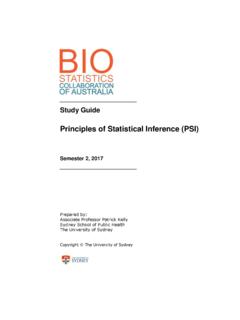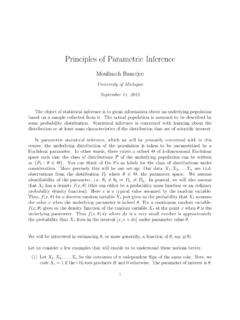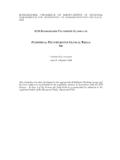Transcription of Fundamental Statistical Concepts in Presenting Data ...
1 Fundamental Statistical Concepts in Presenting DataPrinciples for Constructing Better GraphicsRafe M. J. Donahue, of StatisticsBiomimetic Therapeutics, , TNAdjunct Associate ProfessorVanderbilt University Medical CenterDepartment of BiostatisticsNashville, TNVersion 20112 Fu n d a m e n t a l St a t iS t i cS co n c e p tS i n pr eS e n t i n g da t aThis text was developed as the course notes for the course Fundamental Statistical Concepts in Presenting data ; principles for Constructing Better Graphics, as presented by Rafe Donahue at the Joint Statistical Meetings (JSM) in Denver, Colorado in August 2008 and for a follow-up course as part of the American Statistical Association s LearnStat program in April 2009.
2 It was also used as the course notes for the same course at the JSM in Vancouver, British Columbia in August 2010 and will be used for the JSM course in Miami in July document was prepared in color in Portable Document Format (pdf) with page sizes of by 11in, in a deliberate spread format. As such, there are left pages and right pages. Odd pages are on the right; even pages are on the left. Some elements of certain figures span opposing pages of a spread. Therefore, when printing, as printers have difficulty printing to the physical edge of the page, care must be taken to ensure that all the content makes it onto the printed page. The easiest way to do this, outside of taking this to a printing house and having them print on larger sheets and trim down to , is to print using the Fit to Printable Area option under Page Scaling, when printing from Adobe Acrobat.
3 Duplex printing, with the binding location along the left long edge, at the highest possible level of resolution will allow the printed output to be closest to what was desired by the author during that this is version A large number of changes and enhancements have been made, many of them prompted by many kind readers (MD, HD, BH, WZ, PD, TK, KW, JF, and many others!) who have offered constructive criticism and feedback based on the original Version that was used with the JSM class in July 2008 and on Version that has been in place since early 2009. The author is aware, however, of the very high possibility of there still being any number of typos, gram-matical errors, and misspellings. As always, gently alerting the author (via email at or in person) will greatly improve upcoming versions.
4 Thank i n c i p l eS F o r co nS t r u c t i n g Be t t e r gr a p h i cS 3T his book carries the rather promising, and perhaps over-achieving, subtitle principles for Constructing Better Graphics ; what does that imply about what you will find in the text that follows? What, specifically, are better graphics?The risk of using a word like better is that there can be disagreements as to what that word actually means. In order to avoid these disagreements, let me state up front what I mean when I refer to better believe that a Fundamental purpose of Statistical graphics is to improve under-standing of what the data mean since we collect data in an effort to make infer-ence about some process about which we might not have perfect understanding.
5 Consequently, we are seeking to be inferentialists: we seek to make inference and we want that inference to be valid; we want to avoid being duped or fooled or misled. We want our inference to allow us to make accurate and reproducible descriptions about the past and predictions about the future. We want legitimate inference , inference that will stand up to scrutiny and all manners of attack. We want justifiable, tenable, and defensible conclusions. We are not seeking to spin or manipulate or want , better graphics will promote understanding the data and the process from which they came. They will not necessarily have pop or flash or be atten-tion-grabbing. They will focus on the data and will let the data is in the book?
6 This book is a collection of examples and descriptions of what to see and what works and what doesn t. It grew from a series of lectures and informal talks I gave while at Vanderbilt and reached its current form as the course notes for this class. At its heart, it is a collection of things I have learned, things I have stolen lifted borrowed from found that others have done, things I have discovered on my own. It is Hey, look at this! and Here s why this works and This is the general principle that can be used elsewhere. It is based on nearly 20 years of post-graduate work as a book is a collection of principles that will help us determine what to do when trying to decide how to display our Statistical data .
7 The principles will help us discern better (and worse!) ways to show our book is about my experience and journey to discover understanding in the field of Statistical book is sometimes an example of breaking the very principles that it lays is not in the book?This book does not contain any sort of Absolute Truth that can be followed al-ways, in every book does not have answers to every question you can Fu n d a m e n t a l St a t iS t i cS co n c e p tS i n pr eS e n t i n g da t aThis book does not deliver edicts like Never use a pie-chart or Always make the axes cover every conceivable datum .This book is not perfect. There are likely typos and errors. There is opportunity for improvement. This book is not about pop and data , seeing individual data atoms and how they incorporate to syn-thesize a distribution, goes hand-in-hand with analysis and investigation of data .
8 Pictures are worth more than a thousand words; they are i n c i p l eS F o r co nS t r u c t i n g Be t t e r gr a p h i cS 5 The two Fundamental acts of science, description and comparison, are facili-tated via models. By models, we refer to ideas and explanations that do two things: describe past observations and predict future outcomes. Brad Efron , in an editorial in AmStat News, discusses statistics and the rules of science. In particular, he references Richard Proctor s 19th-century maps of future solar transits of Venus those times in which it will be possible to see, with feet planted firmly on our planet, Venus pass between the earth and the sun. Two such occurrences exposed by Proctor in 1874 are transits predicted on June 8, 2004 and on June 6, 2012.
9 The maps detail the locations on the earth where one can observe this celestial wonder. The heliocentric model of our solar system is a grand example of a scientific model, one that allows us to compute the exact dates and times of transits of Venus, solar and lunar eclipses, and exact times of equinoxes and solstices. It allows us to compute dates of Easter and has enabled us to send spacecraft to orbit and land on other planets. In Efron s words, it exemplifies the prestige and power of what science connotes in modern society. The Laws of Nature, as discovered by Newton, Galileo, Kepler, and their peers, are clockwork-like de-terministic models that have helped pull our society, albeit kicking and scream-ing, into a modern scientific models of Newton and Galileo, those used by Proctor and still being used today, describe deterministic behavior; they have little room for Statistical in-ventions like variation and random error.
10 Statistical models, then, allow us to describe past observation and predict future outcome not with the certainty of Proctor, but within the confines of our understanding of probability and random-ness. Statistical models become tools for understanding sources of history of science over the centuries can be written in terms of improve-ments in resolution . Galileo s invention of the telescope and Leeuwenhoek s microscope improved our ability to see large worlds far away and small worlds close at hand. Each improvement in resolution has removed a layer of what was previously thought to be noise and replaced it with explanation. Statistical models serve as tools to understand sources of variation and allow us to investi-gate more intricate natural phenomena.



















